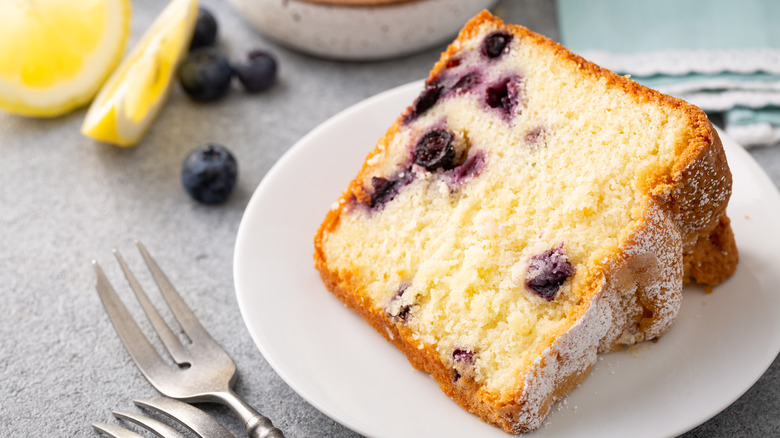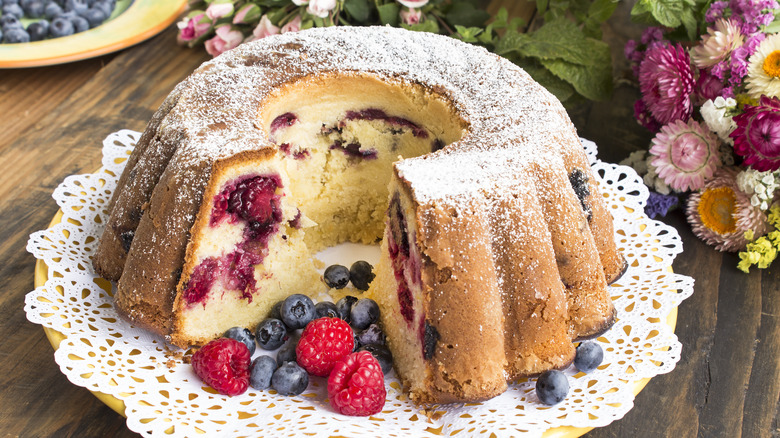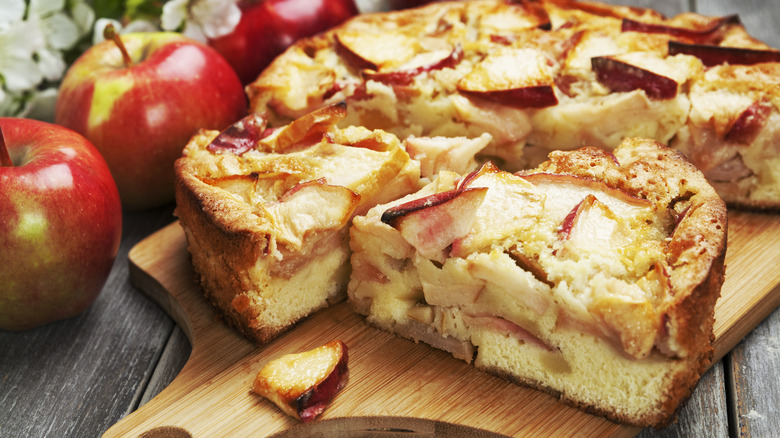The Simple Hacks That Prevent Fruit From Sinking To The Bottom Of Cakes
Some people crave chocolate and caramel, others peanut butter or vanilla. But to many, nothing beats a baked good that's chock-full of fruit or fresh berries. It's the best of both worlds: something a little sweet and indulgent, bolstered by the nutrition found in things like blueberries, apples, and stone fruit. But if you've ever tried making a fruit-filled cake at home, you may have fallen victim to the soggy-bottomed despair that comes when you cut into your baked good, only to find your slice mushy and wet because all of the fruit sank to the bottom of the pan as it bakes. Even worse, the fruit and its juices contain sugar, which burns more readily than the batter. A burnt, mushy, wet cake or muffin? It's a good way to ruin a birthday or a breakfast.
Thankfully, there is a simple way to prevent bottom-heavy fruit cakes and muffins, and you don't even need to buy any special ingredients. It's as easy as spreading a layer of plain batter into your baking pan before making a fruit-filled cake recipe or adding an extra scoop of fruit-free batter to your muffin tin liners before baking.
Use a scoop of plain batter to stop fruit from sinking
Why do berries sink to the bottom of the batter when you're making cakes and muffins? It's simple gravity at work. If your fruit is heavier than the batter it's baking in, there will be a tendency for it to fall to the bottom of the pan. To solve this problem, one of the simplest solutions is to add a cushion at the bottom of the pan, and extra batter does the trick. In most recipes, you fold or stir the fruit into the cake or muffin batter at the end, right before putting it into the baking pan. But before you do that, try taking a scoop of the plain batter, and spreading it onto the bottom of your baking pan or into the bottoms of your muffin tin liners.
Then you can fold the fruit into the batter, and add that on top of the plain batter you already placed in the pan. The fruit may still sink a bit as it bakes, but there is more cushion at the bottom of the pan, so it's less likely to sink all the way to the bottom, where it would result in a soggy, sticky mess. This hack works best with thick batters, like those for coffee cakes, pound cakes, bundt cakes, quick breads, and muffins. But if your batter is on the thinner side, you might want to combine this trick with another common hack for a bit of bakers' insurance.
For added support coat fruit and berries in flour
Fruit is more likely to sink to the bottom of the pan if the cake you're making has a thinner batter. Deb Wise, a professional baker, recipe tester, and developer, shared her tips for adding fruit to thin cake batters with Southern Living. First, she recommends that all fruit get blotted with paper towels before you bake with it, to help eliminate any excess moisture. Then, she adds extra structural support by tossing the fruit into a sieve with flour or cornstarch until it's lightly coated.
Why does this tip work? According to Wise, this starchy coating absorbs the juices that flow out of the fruit as it bakes, creating a barrier between it and the rest of the batter, and keeping it from sliding down. Another tip? Coat fruit using some of the flour that's already called for in the recipe, to avoid a dry crumb. If you're baking a cake, quick bread, or muffin with a thick batter, you still might want to coat your fruit in flour before folding it in, because it can also help prevent color bleeding out of the fruit and into the batter. Using these two simple tips (creating a batter barrier at the bottom of your baking pans and coating fruit in flour), you're that much closer to churning out bakery-quality fruit-filled cakes, muffins, and quick breads at home.


